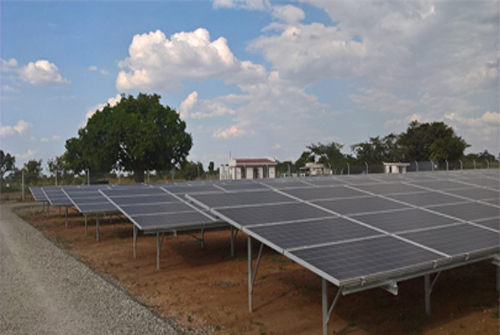Making Green Growth Work in Uganda
By Paul Basudde
 |
|
East Africa's largest solar plant in Soroti, Uganda. Photo credit: Mwesigwa Tony Joshua. |
The total energy consumption in Uganda is estimated at over 5 million tons of oil. Uganda has one of the lowest rates of per capita energy consumption in the world with only 10% of the population having access to electricity and 93% of its total energy consumption is derived from biomass. Consequentially, pollution is on the increase and is accentuated by rapid population growth, urbanization and industrialization, bad urban planning and sanitation.
Uganda’s Greenhouse Gas (GHG) emissions grew 50% from 1990-2012 and increased domestic consumption of petroleum products would likely affect future GHG intensity. In order to control pollution as well as mitigation of climate change impacts, the Uganda government put in place an enabling legal framework in form of The Water Act, Cap 152, and Water Resources Regulations (1998), Waste Discharge Regulations (1998). In addition the Environment Act, and Environmental Impact Assessment Regulations 1998; The National Environment (Standards for Discharge of Effluent into Water or on Land) Regulations 1999 and the National Environment (Waste Management) Regulations of 1999 were put in place to ensure sustainable use of environment and natural resources across the country. There are a number of sites in northern and northeastern as well as the central region of Uganda with potential for generation of wind energy as well as a high nuclear energy potential which can contribute to decarbonizing the energy system. However, these are yet to be fully exploited.
Uganda is seeking to shift towards a green growth pathway, and has included green growth and sustainable development as key elements of the Uganda Vision 2040 plan and the National Development Plan II (2015 – 2020). Mechanisms put in place by Municipal and Town Councils to minimize urban environmental degradation and climate change effects include increased community sensitization, organic agriculture and promotion of tree planting.
Key sectors such as agriculture, fisheries and water resource work to integrate climate targets in their ongoing development plans. The Government of Uganda hopes to promote environmental considerations amongst energy suppliers and consumers as well as establishing a monitoring mechanism to evaluate the compliance or producers with broad targets for the reduction of emissions. Established in 2006, the Uganda Carbon Bureau has been training the public, banking and private sectors in climate change and carbon finance. The aim is to build awareness about climate change, highlight the potential for earning carbon finance and scale up the participation of the financial and private sectors in the carbon market.
For Uganda, data on air pollution is nearly nonexistent. The 2010 Uganda State of the Environment Report acknowledges this lack of air pollution data for Uganda. If decision makers were to pick and choose policies to incentivize stakeholders for decision making to sustain natural resources and human wellbeing things could change for the better. The Ugandan Forestry Policy (UFP) of 2001 and the National Forest Plan (NFP) of 2002 are two examples of such policies. They provide clear roles and responsibilities for the central and local government agencies, the private sector, civil society and local communities.
Green economy offers a potential “win-win” solution to the current financial, socio-economic and environmental crises in Uganda, but rhetoric does not go far enough in advocating sufficient change. The Government seems to understand that without pursuing a green growth pathway, the future of the country would be in jeopardy. Having made a strategic choice to move towards green growth, Uganda is all set for newer and sustainable economic opportunities.
Paul Basudde is senior policy analyst at the ministry of energy and mineral development, Uganda